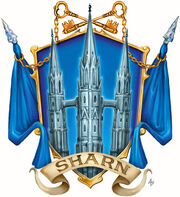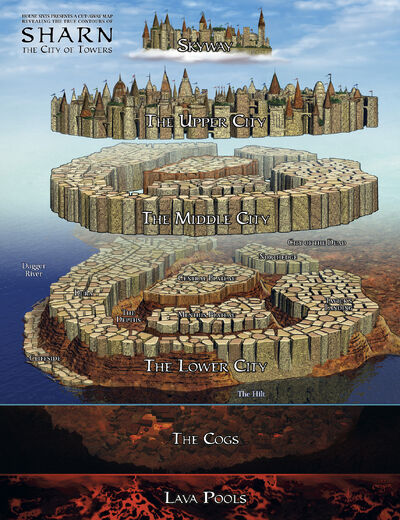Partida Rol por web
Eberron - La Forja Olvidada
Setting - Sharn, La Ciudad de las Torres.

 HISTORY: Sharn is the most populous city in all of Khorvaire, and arguably all of Eberron. The city literally towers atop a cliff above the mouth of the Dagger River in southern Breland.
HISTORY: Sharn is the most populous city in all of Khorvaire, and arguably all of Eberron. The city literally towers atop a cliff above the mouth of the Dagger River in southern Breland.
Sharn is known as The City of Towers, but has also been called many other names, including The City of Knives, The City of Lost Souls, The City of a Thousand Eyes, the Gateway to Xen'drik, and The Gateway to Perdition.
The city now known as Sharn was built upon a foundation that dates back thousands of years before humans ever settled Khorvaire. During that time, the hobgoblin Dhakaani Empire's greatest city was carved into the jagged cliffs that Sharn now towers over. This city was called Ja'Shaarat. This metropolis didn't rise toward the skies, like Sharn does. Instead, the architects of the Dhakaani built a vast number of chambers and tunnels into and under the

ground. As the city grew in size, the Dhakaani eventually would build great monolithic buildings on the plateaus above the Dagger River that would later serve as the foundations for Sharn. When the Daelkyr invaded Eberron, the city was devastated, and the hobgoblins never had a chance to restore it to its greater glory.
Thousands of years later when human settlers from Sarlona began to explore Khorvaire, the Dagger River was stumbled upon. The river led Malleon the Reaver and his explorers to the site where Ja'Shaarat once stood. There he enslaved what goblins still resided in the ruins and erected a fortress within the ruins. He sealed off the lower wards of the ancient hobgoblin city and named the city Shaarat, as a result of stories told by the goblins he enslaved. For 600 years, Shaarat prospered and grew into a powerful metropolis once again. Breggor Firstking, the first ruler of what would become Breland, eventually conquered Shaarat and renamed it Sharn.
Over the course of the next 800 years, Sharn's towers began to rise and the city developed into something resembling Sharn today. Around this time, the Dragonmarked Houses began to prosper and this helped cultivate Sharn into economic power. But the Dragonmarked Houses also brought with them the War of the Mark. The leader of those who bore the aberrant dragonmark, Tarkanan, took control of Sharn and turned it into a home for all who wore the destructive marks.
 Tarkanan couldn't hold the city for long, but in the end he used his terrible powers to destroy much of the city. For the next 500 years, the city was looked down upon and the city remained in ruins. Then, when Galifar I took control of the Five Nations he rebuilt Sharn. The metropolis felt the blessings of Galifar and would eventually develop into the center for trade, diplomacy, and intrigue that it is today.
Tarkanan couldn't hold the city for long, but in the end he used his terrible powers to destroy much of the city. For the next 500 years, the city was looked down upon and the city remained in ruins. Then, when Galifar I took control of the Five Nations he rebuilt Sharn. The metropolis felt the blessings of Galifar and would eventually develop into the center for trade, diplomacy, and intrigue that it is today.
Geography: Sharn looms atop the cliffs overlooking the Hilt, a bay at the mouth of the Dagger River in southern Breland. The city sits upon the foundation of an ancient hobgoblin city. Below that, a rumored lake of molten lava rests, but its presence can be felt only in the lowest parts of Sharn, the Cogs.
The inhospitable outcropping that Sharn sits on allows the city to grow only in vertical height. This might have been a  problem for other cities, but Sharn happens to be located within a manifest zone linked to the plane of Syrania, the Azure Sky. The manifest zone enhances magic that creates flight and levitation. This allows Sharn to have towers that rise nearly a mile in height, transportational flight, and even a section of the city that floats above the highest towers.
problem for other cities, but Sharn happens to be located within a manifest zone linked to the plane of Syrania, the Azure Sky. The manifest zone enhances magic that creates flight and levitation. This allows Sharn to have towers that rise nearly a mile in height, transportational flight, and even a section of the city that floats above the highest towers.
Cityscape: Sharn is a vertical city. It is divided up into five distinct plateaus, as well as a district built into the sides of the cliff near the Dagger River. The five plateaus are known as Central Plateau, Menthis Plateau, Northedge, Dura, and Tavick's Landing. And, Cliffside is a neighborhood perched on the side of the cliff. While each plateau divides the city into districts, the city is also stratified vertically and divided into  several sections. The lowest wards of the city are called The Cogs, and if you were to walk to the heights of Sharn you would pass through The Depths, the Lower City, Middle City, Upper City, and then finally you would need to find some method of travel to the highest section of Sharn, which is Skyway. Generally, the higher you are in Sharn, the wealthier the citizens are.
several sections. The lowest wards of the city are called The Cogs, and if you were to walk to the heights of Sharn you would pass through The Depths, the Lower City, Middle City, Upper City, and then finally you would need to find some method of travel to the highest section of Sharn, which is Skyway. Generally, the higher you are in Sharn, the wealthier the citizens are.
User Input: It was discovered that the spells that create and reinforce the buildings, are stronger if they build off the towers already created. So when a new tower is built, it is designed to anchor off of two or more of the towers below it, the power needed for spells used to maintain is significantly less. For example, this "pile on" effect allows Skyway to exist as its lift spells borrows from ALL the towers below it. The spells maintain the structural integrity of load bearing walls all the way into the earth. This leads to the  interesting architecture. Every tower tries to anchor off of two or three or four of the towers below it, so the lowest structures are dim at best, since direct light is blocked by the of the towers above it. Like series of blocks piled haphazardly on each other, the city looks more like a trunk of a banyan tree, then a series of bamboo shoots.
interesting architecture. Every tower tries to anchor off of two or three or four of the towers below it, so the lowest structures are dim at best, since direct light is blocked by the of the towers above it. Like series of blocks piled haphazardly on each other, the city looks more like a trunk of a banyan tree, then a series of bamboo shoots.
User Input: Sharn is in a warm wet climate and beautiful tropical foliage will grown on every surface if allowed. One way to define an Upper Duras is by being full of light and air and vines and flowers. The towers above shade the Middle Duras so they only get indirect light and less wind.They are dim places of pale vines , shade loving plants and mild breezes. The lower Duras, however, are dark, dank places.  The numerous structures above them, block the light and winds. Nothing grows there and the air is humid and stagnant.
The numerous structures above them, block the light and winds. Nothing grows there and the air is humid and stagnant.
Culture: With several hundred thousand people inhabiting Sharn, it's no surprise that the city is one of the most culturally diverse cities in Khorvaire. From the lush red carpets of Upper City theaters to the dank taverns in the lower slums, Sharn's cultural offerings cater to needs of the wealthy to the very poor. Many districts are inhabited by particular races and offer many of the culinary and commercial offerings from nations abroad. Although Sharn may not have as much political or economic clout as Wroat, the capital of Breland, it is indeed one of the most important cities in the country due to its wide array of cultural offerings.
Leadership: Although the Lord Mayor appears to have the most power in the Sharn government, in actuality it's the City Council who appoints the Lord Mayor. The City Council also commands the Sharn Watch. The Council of Sharn is made up of a councilor from each ward in the city (although Cliffside is merged into Dura, and one councilor represents both Ashblack and Blackbones), to a total of 17 councilors. The City Council establishes laws, determines how to use resources (taxes), and also appoints high officers of the city. While the City Council holds the true power, the Lord Mayor does represent considerable influence in Sharn by being in direct contact with the Brelish Crown.

